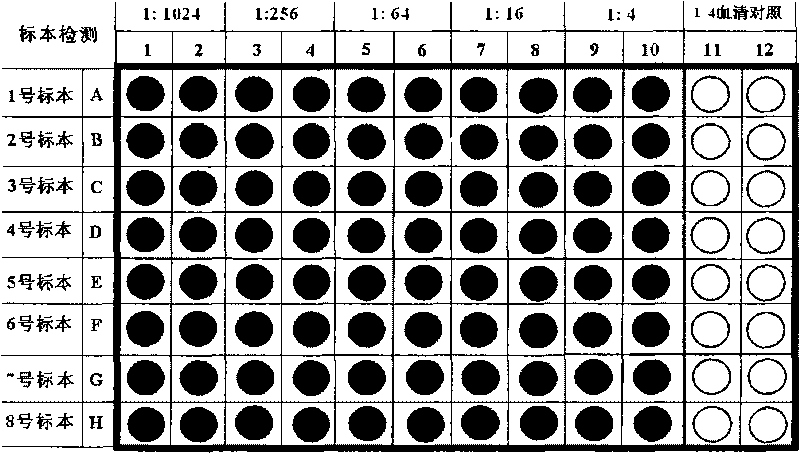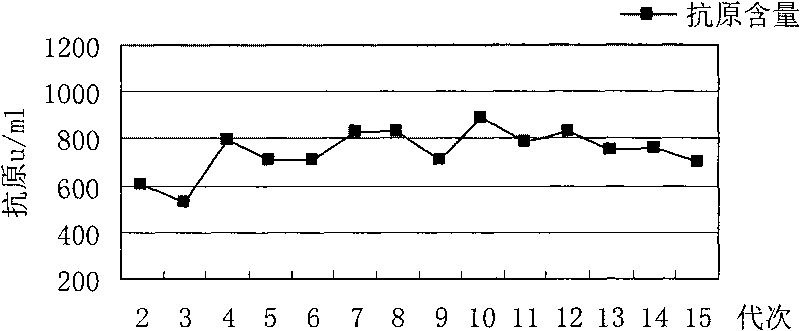Enterovirus type 71 and use thereof
A virus strain, strain technique, applied to a virus that can be used for prophylaxis, force, monoclonal virus strain, and/or purification. ,The field of virus strains for treating or resisting hand, foot and mouth disease can solve the problem of not found HFMD (hand foot and mouth disease, etc.
- Summary
- Abstract
- Description
- Claims
- Application Information
AI Technical Summary
Problems solved by technology
Method used
Image
Examples
Embodiment 1
[0048] Embodiment 1: the cultivation of Vero cell (ATCC CCL81)
[0049] Cell resuscitation method: take the cell seeds out of the liquid nitrogen, centrifuge at 2000 rpm for 5 min, and resuspend the cells with resuscitation solution (MEM medium containing 20% calf serum). The resuspended cells were approximately 1.0 x 10 5 Cell / CM 2 The amount of was inoculated into an empty cell culture flask and incubated overnight (about 16 hr) at 37°C. Then, the growth medium (MEM medium containing 5% calf serum) was replaced, and the cells were continued to be cultured to a monolayer and then passaged.
[0050] The cell subculture method is as follows: the monolayer cells are digested with digestive solution (0.25% trypsin (containing 0.03% EDTA)), and inoculated according to the split ratio of 1:5 (the number of cells is about 1.5-2.0×10 5 ), cultured at 37°C for 2 days for virus subculture, and cultured for 4 days at 37°C for cell subculture. The pH was controlled at 7.2-7.4 durin...
Embodiment 2
[0051] Example 2: Virus Culture
[0052] In the HFMD epidemic area (Fuyang, Anhui) in 2008, throat swab specimens from clinically confirmed typical HFMD patients were collected, frozen at -20°C immediately, and transported to the laboratory for isolation of EV71 virus.
[0053] Thoroughly agitate the throat swab in the specimen preservation solution (at least 40 times) to wash off the virus and virus-containing cells attached to the swab, then centrifuge at 10,000rpm for 20min at 4°C, and filter it out with a 0.22um filter. After bacteria, it was inoculated into the Vero cells cultured in the above-mentioned Example 1 for 2 days to inoculate the virus, and the cell density reached about 80%. Harvest cultures when cytopathic changes (CPE) reach +++ (1+, <25%; 2+, 25%-50%; 3+, 50%-75%; 4+, 75%-100%) , Freezing at -20°C, and then thawing at room temperature, thereby destroying the cells and releasing the virus particles from the cells. Afterwards, the virus particles were harve...
Embodiment 3
[0054] Example 3: Plaque Purification
[0055] The virus seed obtained in embodiment 2 is diluted to 10CCID 50 . The diluted virus seeds were then inoculated onto 6-well plates overgrown with Vero cells for plaque purification.
[0056] Specifically, wash the cell plate twice with PBS, inoculate 1.0ml of virus in each well, absorb at 35°C for 120min, shake the 6-well plate once every 30min, and wash the plate twice with PBS; Mix and prepare nutrient agar, control the temperature at about 45°C, then add nutrient agar to 6-well plate, add 3.0ml to each well. Next, place the 6-well plate at 35°C, 5% CO 2 Cultured in the incubator for 96hr.
[0057] Then, mix equal volumes of liquid A and liquid C, control the temperature at about 45°C, add 3.0ml of staining to each well, and then place the 6-well plate at 35°C, 5% CO 2 Cultured in the incubator for 96hr. Turn the 6-well plate upside down and observe white spots on the bottom of the culture plate. Circle the single circular ...
PUM
| Property | Measurement | Unit |
|---|---|---|
| diameter | aaaaa | aaaaa |
Abstract
Description
Claims
Application Information
 Login to View More
Login to View More - R&D
- Intellectual Property
- Life Sciences
- Materials
- Tech Scout
- Unparalleled Data Quality
- Higher Quality Content
- 60% Fewer Hallucinations
Browse by: Latest US Patents, China's latest patents, Technical Efficacy Thesaurus, Application Domain, Technology Topic, Popular Technical Reports.
© 2025 PatSnap. All rights reserved.Legal|Privacy policy|Modern Slavery Act Transparency Statement|Sitemap|About US| Contact US: help@patsnap.com



